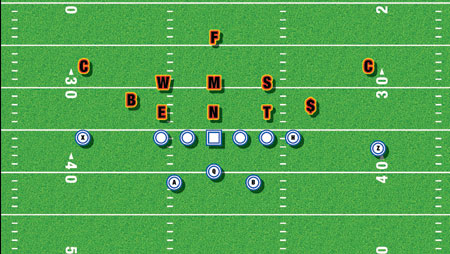Beating the 3-5 at the Line
by: Eric StiegelO.C. and O-Line Coach, Carlson H.S.(MI)©
More from this issue
Offensive coaches at all levels have gone to the “spread” offense in recent years to take advantage of defenses using big and bulky run-stuffers. They’ve used formations with three and four wide receivers to create mismatches and give the QB easy reads vs. predictable fronts and coverages. Who wouldn’t want their best pure athlete lined up in the slot against a linebacker who is comfortable taking on fullbacks and pulling guards in the hole, but not running step-for-step with your speedy slot back?
As coaches, we knew this could only last for so long. The defenses had to come up with something that could match personal and create confusion for both the players and play-callers in the spread offense. So, they rehashed the old 5-3 stack, but super-charged it with smaller, quicker, and more athletic players to neutralize the offenses’ advantage on the field. They decided to give it a new name, too; the 3-5-3, or the 3-3-5. In short, it gave the defense a few ways to catch up with the offense. The first thing it does is put more athletic players on the field. The second thing it does is allow blitzes to come from all over the place at any time. It also has more “moving parts” than the old 5-3 or any even-front defense that we were used to seeing. Moving parts refers to outside linebackers that may line up anywhere from the LOS to safety depth. Now that the defenses have started to catch up, as offensive coaches we must look for the best ways to attack these new more athletic and smaller defenses. And just as the defensive coaches amped up the 5-3 into a new defense, offensive coaches don’t need to re-invent their spread offense to take advantage of the odd stack.
The very same principal that made the spread the most popular offense in college and high school just needs to be reversed. Instead of parading out your four quick wide outs that don’t like to block that much, you can utilize a package with a hand-in-the-ground tight end and a two-back set in the shotgun. Now, as an offensive coach, you again have the advantage. At Carlson High School, out of our “Gun Tight” set we have full disposal of our offense through motions and can take advantage of speed match ups when we see the opportunity. More importantly, we can take advantage of the off-tackle power play and force smaller, more athletic players to play out of their comfort zone. Instead of running with receivers and playing in space, you force the smaller outside linebackers/safeties to play in a phone booth and take on blocks. Best of all, when done with a gap blocking scheme it essentially eliminates the blitz and makes their best tacklers (inside linebackers) get caught in the “wash” when they are aggressive.
Before getting into our gap blocking scheme and power play, it is important to first look at how the odd stack will align to a “Gun Tight” set (See Diagram 1).

As you can see in the diagram, what most teams will do is stay in their base alignment with a slightly rolled-up strong outside linebacker. The next thing to look at is what teams can do out of the odd stack. The odd stack is meant to bring blitzes from many different areas and to confuse an offense, but it is really nothing more than a gap exchange defense (See Diagram 2).

What I mean by this is that if the tackle fired B-gap, the stacked SAM linebacker will go C-gap. The same premise is done by the N and MIKE as well as the End and WILL. The outside linebackers are generally contain players, but are also used to overload a blitz. These blitzes can be confusing to a man-blocking team and can overload a zone scheme (which we also run), but are essentially useless against our gap-schemed power play as the blitzing linebackers get caught in the wash and lead to pulling guards on free safeties.
Now we will look at our gap-schemed power play and why it is so effective vs. an odd stack defense (See Diagram 3).

The beauty of our gap scheme is that it follows one foolproof (and lineman-proof) rule. We teach our kids “GAP, ON, DOWN”. Essentially this means if someone is in your gap (inside shade to head up of lineman to your inside) you block them. If there is no one in your gap, you block “on” - head up, which will be a combination. And if no one is “gap” or “on”, you block down to the second level. This scheme lets us get combinations at the point of attack and on the Nose on virtually every play and forces blitzing backers into the backs of their defensive lineman. These combinations give us great movement on the front line and along with the gap scheme eliminate penetration. Every lineman from the center to the tight end will always use a gap step, which is a small directional step with their inside foot to get them headed on track to protect their gap. This prevents any blitzing from hurting us. The technique of our combinations and gap-block technique is equally important to the scheme, but that is a whole other clinic in itself.
Now that we have discussed the front side of the play we will talk about the fullback, the pulling guard and back-side tackle. The fullback’s job is to attack the first block outside the tight end. This is usually an outside linebacker who is not used to taking on kick-out blocks. The most important thing for the fullback is to get to the block quick and attack him inside out since we do not want this player gaining inside leverage. If he crashes too hard we will log him. The pulling guard will pull and hit the first wrong-colored jersey he sees. Ideally, this leads him into the hole created buy the tackle-tight end combination and the fullback kick onto the Sam backer. But, in general, we tell him to hit anything that gets in his way since we must never pass up blocks. When he is leading through the hole his eyes should be inside. With the multiple blitzes out of the odd stack, many times the Sam and Mike get caught up in traffic and our guard will end up leading on the free safety. The back-side tackle must “fire” his inside gap to protect for the pulling guard and not allow anything to cross his face. He should step flat and seal the back side off along with the center’s gap block.
The gap-schemed power play gives us an advantage on the line of scrimmage and at the point of attack by forcing smaller, more athletic players to play in the trenches and take on blocks which they are not used to or comfortable with. In our “Gun Tight” formation we complement our power with power to the weak side, inside and outside trap, a FB and QB counter run both strong and weak, as well as zone and jet sweep primarily to the weak side. We also utilize our play-action pass game, our quick game, sprint out series, and screens out of our “Gun Tight” formation. We feel that this formation and scheme gives us a personal and schematic advantage against blitz-crazed odd stack defenses.








